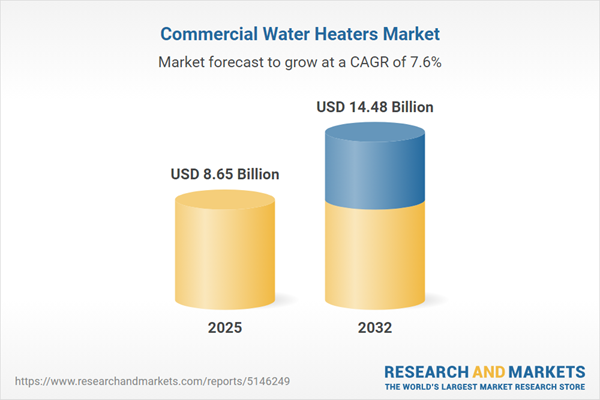Speak directly to the analyst to clarify any post sales queries you may have.
The commercial water heaters market is advancing steadily, driven by regulatory momentum, new technologies, and evolving end-user requirements. Senior industry stakeholders face an environment shaped by decarbonization, rising operational expectations, and supply chain recalibration, influencing product development and strategic planning across global regions.
Market Snapshot: Commercial Water Heaters Market Size and Growth
The commercial water heaters market grew from USD 8.04 billion in 2024 to USD 8.65 billion in 2025. The sector is forecasted to achieve a CAGR of 7.61%, reaching USD 14.48 billion by 2032. Sustained momentum in energy efficiency mandates, rapid modernization, and expansion of smart buildings continue to define the commercial water heaters market’s upward trajectory, reinforcing its importance within infrastructure, industrial, and specialty vertical applications.
Scope & Segmentation: Detailed Market and Technology Coverage
- Energy Source: Electric, gas (condensing, conventional), oil, solar. Electric units increasingly align with decarbonization efforts, while gas and oil solutions remain vital in regions with established fuel infrastructure. Solar units support renewable adoption, particularly in off-grid or incentive-driven markets.
- Product Type: Combination (hybrid, modulating), heat pumps (air source, water source), storage (conventional, high efficiency), tankless (condensing, non-condensing). This diversity reflects end-user demands for versatility, high performance, and space optimization.
- Capacity: Large (>500 gal), medium (100–500 gal), small (<100 gal). Selection is dictated by facility scale, from compact commercial premises to heavy-duty industrial applications.
- Application: Commercial offices, food & beverage, healthcare, hospitality, industrial. Each requires tailored solutions based on flow-rate and recovery priorities.
- Installation: Indoor, outdoor. Design varies to address space, access, and durability needs.
- Distribution Channel: Dealer, direct sales, distributor, original equipment manufacturer partnerships. These channels reflect diverse procurement and sales preferences.
- End-User Industry: Food & beverage, healthcare, hospitality, institutional, manufacturing, highlighting the market's reach and segment specificity.
- Regions: Americas (United States, Canada, Mexico, Brazil, Argentina, Chile, Colombia, Peru), Europe (United Kingdom, Germany, France, Russia, Italy, Spain, Netherlands, Sweden, Poland, Switzerland), Middle East (UAE, Saudi Arabia, Qatar, Turkey, Israel), Africa (South Africa, Nigeria, Egypt, Kenya), Asia-Pacific (China, India, Japan, Australia, South Korea, Indonesia, Thailand, Malaysia, Singapore, Taiwan).
- Leading Companies: A. O. Smith Corporation, Rheem Manufacturing Company, Bradford White Corporation, State Industries LLC, Robert Bosch GmbH, Viessmann Werke GmbH & Co. KG, Ariston Thermo S.p.A., Rinnai Corporation, Navien Inc., Noritz Corporation.
Key Takeaways for Strategic Decision-Making
- Heightened efficiency regulations and decarbonization pledges are prompting rapid innovation, influencing product pipelines, and capital investment priorities.
- Emerging technologies such as heat pump configurations and IoT-enabled monitoring are reshaping user expectations regarding reliability, integration, and lifecycle management.
- Market adaptability is reinforced by the spread of modular architectures, enabling streamlined manufacturing and customization for various segments.
- Regional nuances require tailored strategies—American infrastructure upgrades, EMEA emissions compliance, and Asia-Pacific digitalization all steer market direction differently.
- Competitive advantage increasingly relies on sustainability credentials, integrated service offerings, and the ability to address niche and mainstream end-user demands.
- Partnerships, acquisitions, and R&D initiatives are common as brands seek to deliver holistic, end-to-end solutions extending beyond the heater unit itself.
Tariff Impact: U.S. Policy Changes and Their Implications
Recent United States tariffs have reshaped supply chain strategies by driving manufacturers to reevaluate sourcing, production, and logistics. With increased landed costs and new lead-time challenges, many firms have pursued nearshoring and regional manufacturing to sustain reliability. These shifts have required added investment in talent and plant capacity, impacting pricing models and value-chain collaboration across distributors and end users.
Methodology & Data Sources
This report employs a multi-method approach, integrating primary interviews with procurement managers, engineers, and service providers, alongside structured end-user and channel surveys. Secondary research includes industry publications, regulatory documents, and proprietary supply chain data. Analytical rigor is supported by data triangulation and expert review cycles to ensure consistent, actionable results.
Why This Report Matters: Strategic Value for Senior Decision-Makers
- Clarifies where investment in technologies and regional solutions can yield the greatest business impact.
- Provides in-depth analysis of evolving regulatory, supply chain, and market conditions to inform risk management and growth planning.
- Supports data-driven decisions with granular segmentation and actionable insights into competitive strategies and customer requirements.
Conclusion
The commercial water heaters market demands agile responses to change, integration of smart technologies, and localized strategies. Decision-makers equipped with timely insights can target opportunities and optimize portfolios for ongoing resilience and growth.
Additional Product Information:
- Purchase of this report includes 1 year online access with quarterly updates.
- This report can be updated on request. Please contact our Customer Experience team using the Ask a Question widget on our website.
Table of Contents
3. Executive Summary
4. Market Overview
7. Cumulative Impact of Artificial Intelligence 2025
List of Figures
Samples

LOADING...
Companies Mentioned
The key companies profiled in this Commercial Water Heaters market report include:- A. O. Smith Corporation
- Rheem Manufacturing Company
- Bradford White Corporation
- State Industries, LLC
- Robert Bosch GmbH
- Viessmann Werke GmbH & Co. KG
- Ariston Thermo S.p.A.
- Rinnai Corporation
- Navien Inc.
- Noritz Corporation
Table Information
| Report Attribute | Details |
|---|---|
| No. of Pages | 188 |
| Published | October 2025 |
| Forecast Period | 2025 - 2032 |
| Estimated Market Value ( USD | $ 8.65 Billion |
| Forecasted Market Value ( USD | $ 14.48 Billion |
| Compound Annual Growth Rate | 7.6% |
| Regions Covered | Global |
| No. of Companies Mentioned | 11 |









